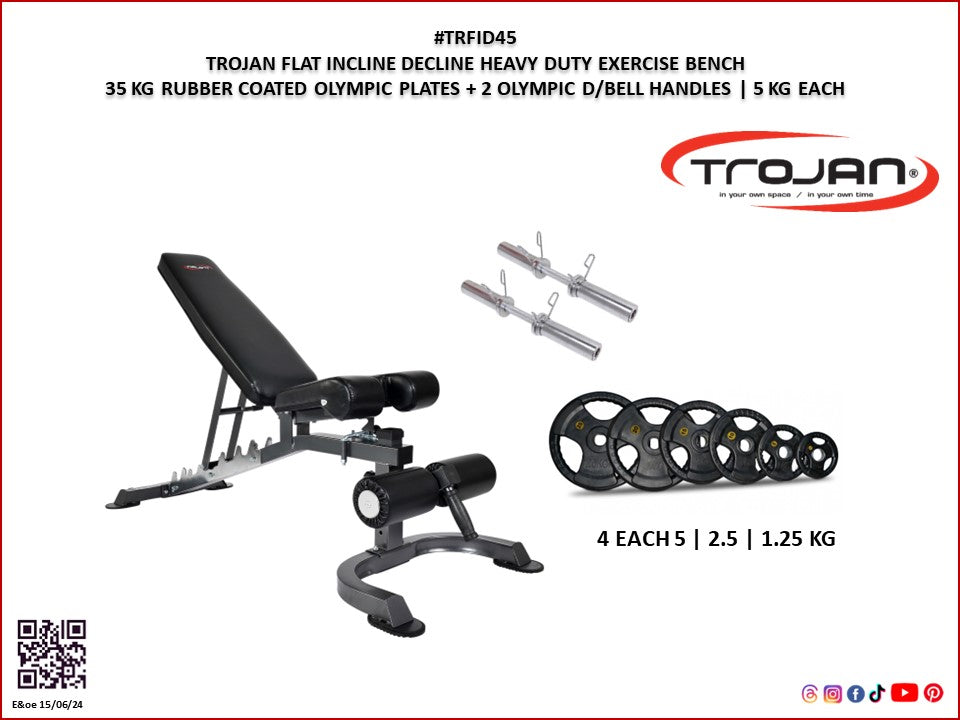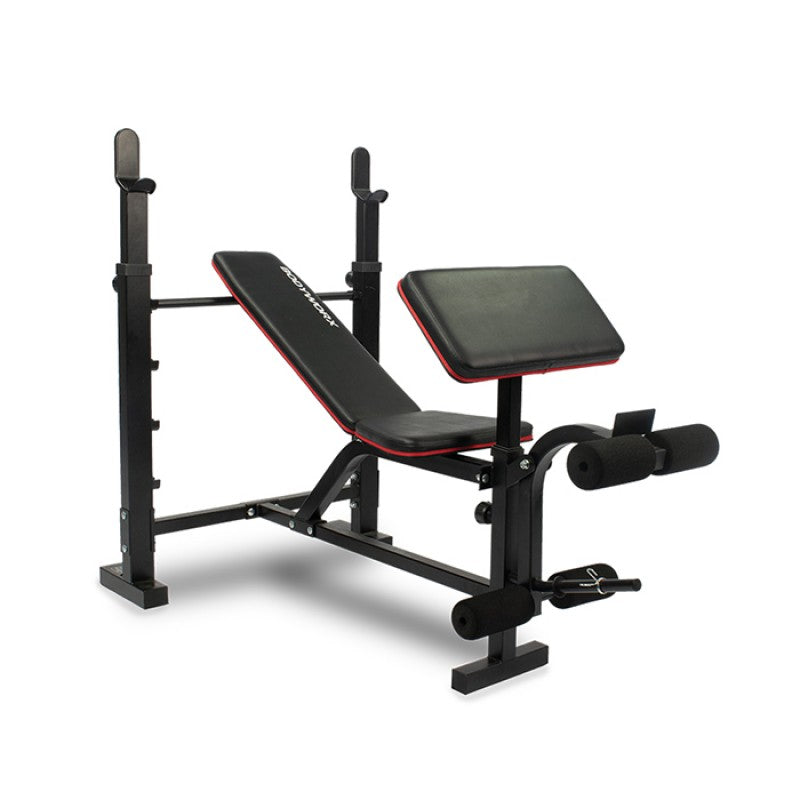So, you wanna build a chiseled chest that turns heads and makes T-shirts feel tight in all the right places? Well, mate, you’ve got two heavy hitters in your corner. The chest press and the bench press.
One is your reliable, no-nonsense gym buddy that keeps things controlled. While the other is that wild, free-spirited friend who makes you stronger but also makes you sweat a whole lot.
Both will give you pecs of steel. But which one deserves the top spot in your routine? Trojan Fitness is here to make you decide once & for all.
At Trojan Fitness, we don’t just talk about gains, we help you make them happen. Whether you're setting up a home gym or levelling up your gear. We got top-tier fitness equipment ready to ship Australia-wide. So, you can train on your terms in your own space.
Grab your lifting straps and let’s settle this chest-day debate!
Chest Press vs. Bench Press Muscles Worked
Before we move towards the technique and benefits. Let’s first explore the muscles working in both chest press & bench press workout. So, you can have a clear picture of how they will transform you.
Bench Press Workout What Muscles?
The bench press is a compound movement that activates multiple muscle groups. E.g.
- Pectoralis Major & Minor (Chest Muscles): The primary movers responsible for pressing the weight.
- Triceps Brachii: Helps extend the elbows and lock out the movement.
- Anterior Deltoids (Front Shoulders): Assists in pushing the weight upward.
- Core Muscles: Engaged for stability, especially during heavier lifts.
- Latissimus Dorsi (Back Muscles): Provides control when lowering the barbell.
How to Perform the Bench Press?
The bench press is a fundamental movement in strength training. It needs the following steps for proper execution and prevention of injuries.
1. Setup:
- Lie flat on a bench with feet planted firmly on the ground.
- Grip the bar slightly wider than shoulder-width.
- Keep your shoulders pinned back and chest lifted.
2. Execution:
- Unrack the bar and lower it slowly to your mid-chest.
- Keep elbows at a 45-degree angle, not flared out.
- Push the bar back up in a straight line until arms are extended.
3. Breathing & Tips:
- Inhale as you lower the bar, exhale as you press up.
- Keep your wrists straight to avoid unnecessary strain.
- Use a spotter when lifting heavy to ensure safety.
For More Details: How to Bench Press | Master this Classic Chest-Builder with Proper Form
Now let’s move toward the advantages & disadvantages of each one.
Pros of Bench Press
On the other hand, benching in the gym allows more flexibility and push your body for more. Talking about it benefits:
-
Builds Full-Body Strength & Stability
The bench press workout doesn’t just hit your chest. It activates your shoulders, triceps, core, and even legs for extra power and control.
-
Improves Athletic Performance
Because it mimics natural pushing movements. Athletes in sports like football, basketball, and combat sports benefit more from bench pressing at the gym than from machines.
-
More Versatile Than Machines
You can switch it up. Barbell bench press, dumbbells, or even a bench press with machine. Want to hit different angles? Adjust your grip or incline for a new challenge!
-
Better for Strength Gains & Muscle Growth
Because it recruits more muscle fibres, the bench press is king for overall chest development.
-
Customisable Grip & Range of Motion
Unlike machines that lock you into one position, dumbbells and barbells let you tweak your form to match your body structure and avoid injuries.
Cons of Bench Press
While doing bench press, beware for:
-
Higher Injury Risk if Done Incorrectly
Poor form can lead to shoulder impingement, wrist strain, or even pec tears. It’s important to learn proper technique before going heavy.
-
Requires a Spotter for Heavy Lifting
Unlike the seated bench, where you can simply re-rack the weight. The free-weight bench press can be dangerous without someone to help if you fail a rep.
-
Harder to Master
As it involves advanced & reckless technique, getting it right takes practice. Especially balancing a heavy barbell without wobbling is difficult.
Equipment Needed for Bench Press
Flat or Adjustable Bench:

It is essential for proper support needed during seated chest press or bench press. You can get our Flat Bench with Dumbbell Storage Rack for strength.
Or our Exercise HD Bench Incline Decline GT can give you better flexibility.

Barbell and Plates:

They are standard equipment for a traditional bench press. For best results, choose our Olympic Barbell & Weights.
It consists:
- 135 Kg Pack of weights
- 20 Kg Olympic 7' 20 Kg Barbell
- Rubber Barbell Pad for better grip
- Pair Collars PU for protection
Dumbbells:

For variations like the chest dumbbell bench press, you’ll need strong & durable dumbbells. You can explore our dumbbells variety here.
Chest Press Workout What Muscles?
A chest press machine works similar muscle groups but removes the need for stability. It includes:
- Pectorals (Chest): Main target, like the bench press.
- Triceps: Helps with arm extension.
- Anterior Deltoids: Assists with pressing movement.
- Minimal Core Engagement: Since the machine controls stability, core activation is reduced.
If you’re looking for maximum muscle activation, the bench press and dumbbells combination is better for you. However, if you're after a controlled & isolated workout. The seated chest press is an excellent choice.
Let’s talk about the technique.
How to Perform the Chest Press?
The machine bench press offers a guided & controlled movement for isolating chest muscles. Here’s how to do it right:
1. Setup:
- Adjust the seat so that handles are at mid-chest level.
- Sit with a firm grip on the handles, feet flat on the floor.
2. Execution:
- Press the handles forward until arms are fully extended.
- Pause briefly, then slowly return to the starting position.
3. Breathing & Tips:
- Inhale as you lower the handles, exhale as you press.
- Avoid fully locking out your elbows to reduce joint stress.
- Keep a controlled tempo, don’t rush the movement.
For More Details: Chest Press Exercise | How to Get its Maximum Benefit?
Pros of Chest Press
If you're new to strength training. You should consider seated bench press to start before transitioning to free weights.
-
Beginner-Friendly & Easy to Learn
If you’re just starting out, the sitting chest press is your best friend. No balancing a heavy bar. No worrying about getting stuck under a failed rep. Just sit, push, and grow.
-
Safer for Joints & Reduces Injury Risk
Since the seated chest press follows a fixed path. There’s less strain on your shoulders and wrists compared to free weights. Plus, you can focus on muscle activation without stressing about improper form.
-
Perfect for Muscle Isolation
Want to laser-focus on bench press muscles worked (a.k.a. your pecs)? The machine bench press eliminates the need for stabilizer muscles. So, your chest does all the heavy lifting.
-
Great for High-Volume Training
Because of its stability, you can pump out more reps with heavier weights without worrying about losing control. This makes it perfect for burnout sets and hypertrophy training.
-
No Spotter Needed
Unlike a bench press workout, where a missed rep could mean getting pinned under the bar. The chest press lets you train solo safely.
Cons of Chest Press
Although great for stability, chest press has following limitations in advanced training.
-
Limited Range of Motion
Unlike the chest dumbbell bench press, which allows a deep stretch in the pecs, the machine keeps your movement locked into a specific range. Less stretch = less muscle fibre engagement.
-
Less Core & Stabilizer Muscle Activation
Since the machine provides support, your shoulders, triceps, and core don’t work as hard. This means you miss out on full-body strength benefits.
-
Not as Functional for Sports & Real-Life Strength
While great for muscle building, it doesn’t mimic real-world pushing movements better than bench press. Athletes benefit more from free-weight training.
-
Machine Dependency
If you always rely on a machine, transitioning to free weights can feel tough. Your muscles get used to assisted movement and get weaker in unsupported positions.
Equipment Needed for Chest Press
Chest Press Machine:

It is the main equipment needed for any chest press variations. You can consider our Home Gym Inc 205 Lbs Stack Chest Press Fly's Pecs Preacher Leg Ext & Preacher Curl.
It offers:
- 94 kg/205 lb solid vinyl weight stack
- High & low pulley systems with attachments
- Adjustable butterfly and backrest pad
- Lockable password protector
- Butterfly reverse system for seated row
With the help of it, you can perform:
- Leg extension & curl
- Seated preacher curl
- Leg back kick
- Leg adductor strengthening
- Tricep push down
- Standing bicep curl
Chest Press Vs Bench Press | The Final Verdict
Your choice depends on your fitness level and goals. For:
- Beginners: A seated bench press is safer and easier to control.
- Strength Seekers: The bench press and dumbbells combo is best for building muscle.
- Muscle Isolation: with focus purely on chest development, go for a machine bench press.
In an ideal scenario, incorporating both exercises into your chest and workout routine can provide balanced development.
Need Equipment for Benching at Gym Setup of Your Own or Doing Chest Press at Home?
Level Up Your Chest Workouts with Trojan Fitness
At Trojan Fitness, we stock a range of bench press with machine setups, dumbbells, and benches. That can help you train on your own terms. With nationwide delivery and expert installation services. Setting up your dream home gym has never been easier.
So, no more waiting for a free bench at the gym.
Check Our Collection of Benches & Smith Machines
Explore Our Entire Strength Equipment
And start lifting like a champ!
Disclaimer:
The information provided on this website is intended for general informational purposes only and should not be considered professional or medical advice. We make every effort to ensure the information provided is accurate and up-to-date, but we cannot guarantee the accuracy, completeness, or timeliness of the information. Any reliance you place on such information is strictly at your own risk. Always consult a qualified professional before making any significant changes to your diet, exercise routine, or lifestyle. We are not responsible for any adverse consequences resulting from the use of, or reliance on, any information provided on this website.
 All Payment Methods are Accepted
All Payment Methods are Accepted










